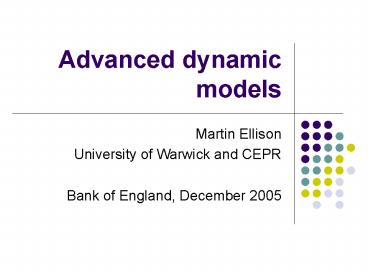Advanced dynamic models PowerPoint PPT Presentation
Title: Advanced dynamic models
1
Advanced dynamic models
- Martin Ellison
- University of Warwick and CEPR
- Bank of England, December 2005
2
More complex models
- Frisch-Slutsky paradigm
3
Impulses
- Can add extra shocks to the model
Shocks may be correlated
4
Propagation
- Add lags to match dynamics of data (Del
Negro-Schorfeide, Smets-Wouters)
Taylor rule
5
Solution of complex models
Blanchard-Kahn technique relies on invertibility
of A0 in state-space form.
6
QZ decomposition
- For models where A0 is not invertible
7
Recursive equations
stable unstable
Recursive structure means unstable equation can
be solved first
8
Solution strategy
Solve unstable transformed equation
Substitute into stable transformed equation
Translate back into original problem
9
Simulation possibilities
- Stylised facts
- Impulse response functions
- Forecast error variance decomposition
10
Optimised Taylor rule
- What are best values for parameters in Taylor
rule ?
Introduce an (ad hoc) objective function for
policy
11
Brute force approach
- Try all possible combinations of Taylor rule
parameters
Check whether Blanchard-Kahn conditions are
satisfied for each combination
For each combination satisfying B-K condition,
simulate and calculate variances
12
Brute force method
- Calculate simulated loss for each combination
Best (optimal) coefficients are those satisfying
B-K conditions and leading to smallest simulated
loss
13
Grid search
For each point check B-K conditions
2
1
Find lowest loss amongst points satisfying B-K
condition
0
1
2
14
Next steps
- Ex 14 Analysis of model with 3 shocks
- Ex 15 Analysis of model with lags
- Ex 16 Optimisation of Taylor rule coefficients
PowerShow.com is a leading presentation sharing website. It has millions of presentations already uploaded and available with 1,000s more being uploaded by its users every day. Whatever your area of interest, here you’ll be able to find and view presentations you’ll love and possibly download. And, best of all, it is completely free and easy to use.
You might even have a presentation you’d like to share with others. If so, just upload it to PowerShow.com. We’ll convert it to an HTML5 slideshow that includes all the media types you’ve already added: audio, video, music, pictures, animations and transition effects. Then you can share it with your target audience as well as PowerShow.com’s millions of monthly visitors. And, again, it’s all free.
About the Developers
PowerShow.com is brought to you by CrystalGraphics, the award-winning developer and market-leading publisher of rich-media enhancement products for presentations. Our product offerings include millions of PowerPoint templates, diagrams, animated 3D characters and more.

